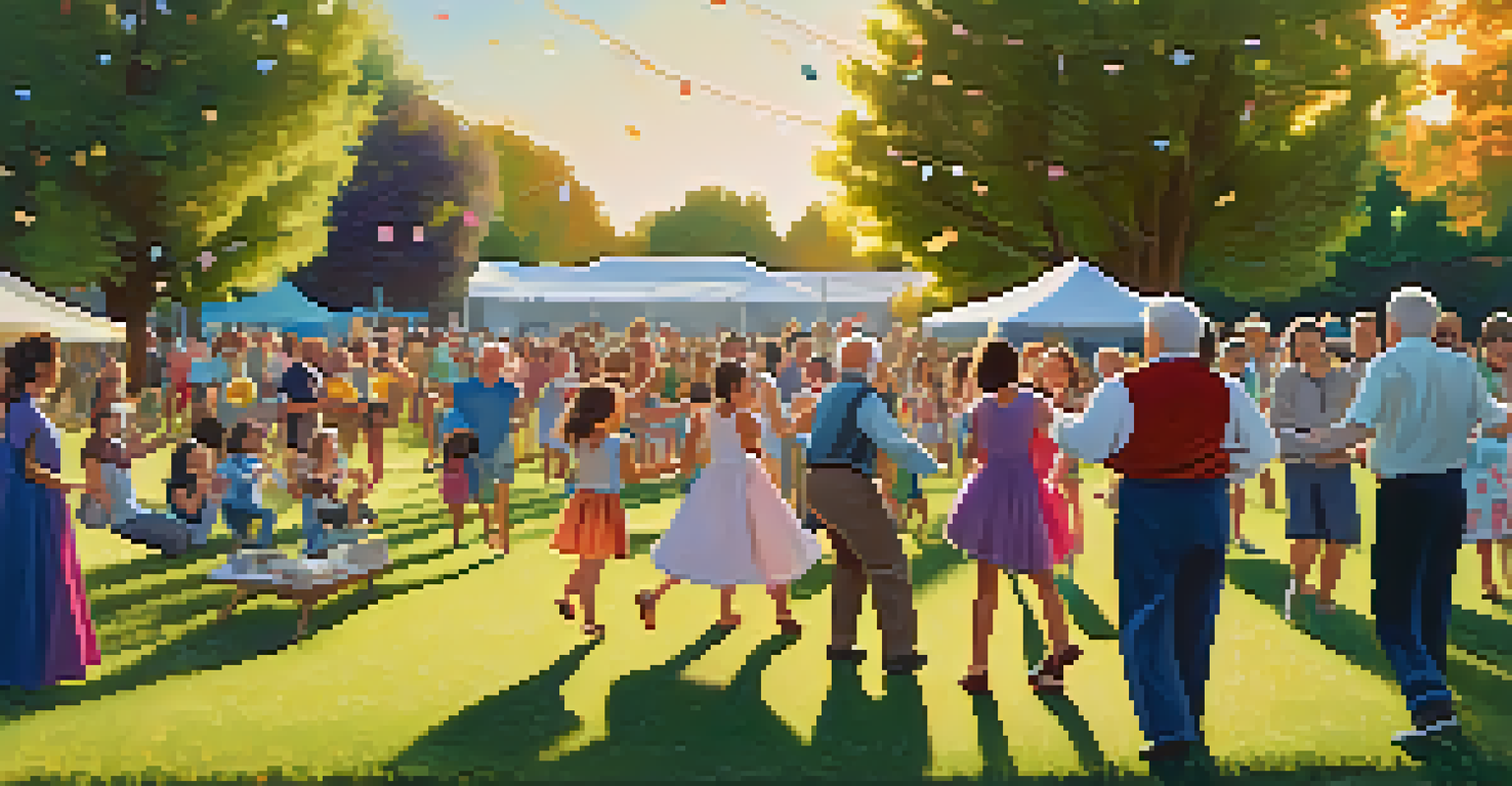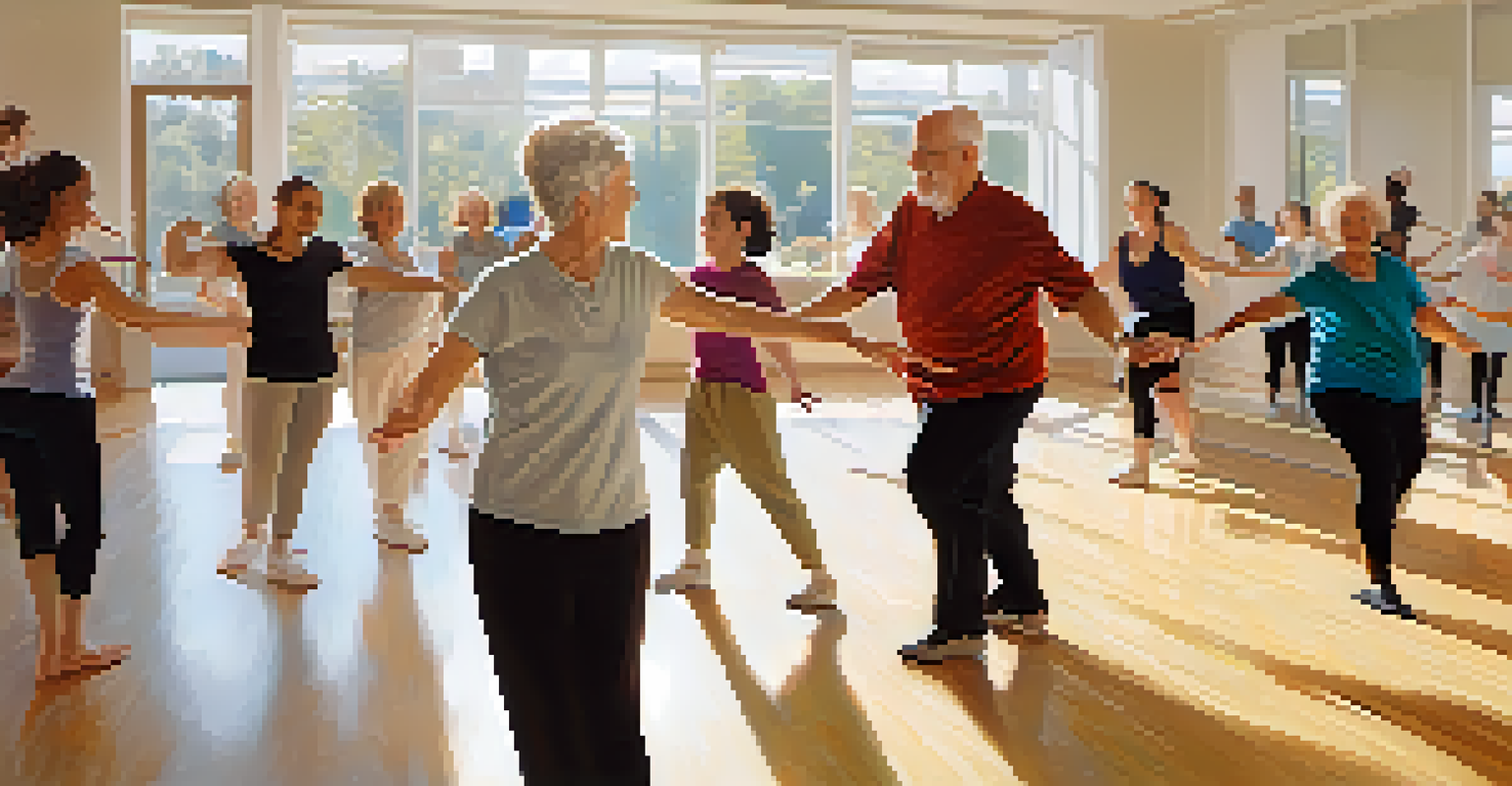Intergenerational Dance Programs: Bridging Age Gaps

Understanding Intergenerational Dance Programs
Intergenerational dance programs bring together participants from various age groups, often pairing younger dancers with seniors. This unique approach not only promotes physical activity but also fosters understanding and connection between generations. By engaging in dance, participants share their experiences, perspectives, and cultures, creating a vibrant community atmosphere.
Dance is the hidden language of the soul.
These programs can vary widely, from structured classes to informal dance gatherings. They may feature a mix of traditional dances from different eras or modern styles that encourage creativity and expression. Regardless of the format, the focus remains on collaboration and mutual enjoyment, making it a delightful experience for everyone involved.
As society becomes more fragmented, intergenerational initiatives like these play a crucial role in bridging the gap between ages. They help dismantle stereotypes and foster empathy, reminding us that we all share similar joys, struggles, and aspirations—most notably, the joy of dance.
The Benefits of Dance for All Ages
Dance is a universal language that transcends age, offering physical and mental benefits for everyone. For older adults, it can improve balance, coordination, and cognitive function, while younger participants develop social skills and confidence. Engaging in dance also promotes emotional well-being by reducing stress and increasing feelings of happiness.

Moreover, dancing together in a supportive environment fosters camaraderie and breaks down barriers. Participants often share laughs and stories, creating bonds that extend beyond the dance floor. This sense of belonging is essential for both older adults, who may face isolation, and younger individuals, who thrive on connection.
Dance Connects Generations
Intergenerational dance programs foster understanding and connection between different age groups through shared experiences and movement.
The physicality of dance also encourages a healthy lifestyle, which is beneficial for all ages. Whether it’s a lively salsa or a serene waltz, every step taken contributes to a more active and fulfilling life, reinforcing the idea that age is just a number when it comes to enjoying movement.
Creating Inclusive Dance Environments
To ensure dance programs are accessible, it's vital to consider the varying needs and abilities of participants. Offering modifications and alternative movements can accommodate all skill levels, making everyone feel welcome. Inclusivity not only enhances the experience but also enriches the learning environment for everyone involved.
The connection between generations is the glue that holds a community together.
Instructors play a crucial role in fostering an inclusive atmosphere. They should be trained to recognize and celebrate the unique strengths of each participant, promoting a culture of respect and encouragement. By doing so, they help create a space where everyone feels valued, regardless of their age or experience.
Additionally, community support can enhance these programs significantly. Collaborating with local organizations, schools, and senior centers can provide resources and volunteers, ensuring a well-rounded experience that meets the diverse needs of participants.
Success Stories from Intergenerational Programs
Many intergenerational dance programs have showcased remarkable success stories, highlighting the profound impact they can have on participants. For example, one program paired high school students with nursing home residents, resulting in friendships that blossomed beyond the dance floor. These connections enriched the lives of both groups, promoting understanding and appreciation for each other's experiences.
Another inspiring story comes from a community event where families of all ages participated in a dance-off. Not only did they enjoy a fun-filled day, but they also shared stories from their generations, creating a tapestry of experiences that celebrated diversity and unity. This kind of engagement can lead to lasting relationships and a stronger sense of community.
Health Benefits for All Ages
Engaging in dance promotes physical, mental, and emotional well-being, offering significant benefits for both older adults and younger participants.
These success stories illustrate that the benefits of intergenerational dance programs extend far beyond the physical activity involved. They foster a sense of belonging, enhance social skills, and create lasting memories that participants can cherish for years to come.
Overcoming Challenges in Implementing Programs
While the benefits of intergenerational dance programs are clear, there are challenges to consider when implementing them. Limited funding and resources can restrict the ability to offer diverse programs and reach a wider audience. Creative solutions, such as partnering with local businesses or applying for grants, can help overcome these obstacles.
Another challenge is encouraging participation from both older adults and younger generations. Some might feel hesitant about joining a program with a different age group. To address this, outreach efforts should emphasize the fun, social aspects of dance, highlighting testimonials from previous participants who have benefitted from the experience.
Lastly, finding qualified instructors who understand the unique dynamics of intergenerational settings can be difficult. Investing in training for dance teachers and encouraging them to develop engaging, age-appropriate curricula can help ensure that programs are effective and enjoyable for everyone.
Tips for Starting Your Own Intergenerational Dance Program
Starting an intergenerational dance program can be a rewarding endeavor, and there are a few key steps to consider. First, identify a community space that is accessible for all ages, such as a local community center or school gym. Ensuring a welcoming environment is crucial for attracting participants from different backgrounds.
Next, gather input from potential participants about their preferences in terms of dance styles and scheduling. This collaborative approach not only fosters ownership but also ensures that the program caters to the interests of the community. Remember, the more inclusive the program, the more likely it is to thrive.
Inclusivity Enhances Learning
Creating inclusive dance environments accommodates diverse needs and abilities, enriching the experience for all participants.
Lastly, promote your program through social media, local events, and word-of-mouth. Engaging local schools, senior centers, and community organizations can help spread the word and bring in a diverse group of participants eager to share their passion for dance.
The Future of Intergenerational Dance Programs
As society continues to evolve, the need for connection between generations remains strong. Intergenerational dance programs will likely play an increasingly important role in fostering community, empathy, and understanding. By embracing the joy of movement, these programs can help bridge the gap between ages and create lasting relationships.
Innovation in dance programming—such as virtual classes or outdoor events—will also contribute to their growth. These adaptations can make dance more accessible, allowing participants to join from the comfort of their homes or in safe, open spaces. The flexibility of these formats ensures that everyone can participate, regardless of their circumstances.

Ultimately, the future of intergenerational dance programs lies in their ability to adapt and thrive, continuing to unite people of all ages through the simple joy of dance. By fostering inclusivity and celebrating diversity, these programs can create a world where every generation can share, learn, and grow together.